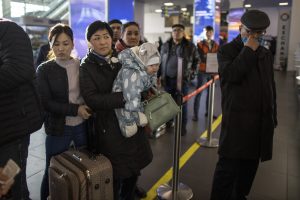As Central Asia began registering earlier this month its first cases of COVID-19, the disease caused by the novel coronavirus now spreading across the world, the region’s migrant workers were on the move. In spring each year, a significant number of Central Asians migrate for seasonal work — many to Russia. The coronavirus, wrecking havoc on even the most advanced healthcare systems the world over, is also causing devastating economic damage as borders close and trade grinds to a halt.
Central Asia’s migrant workers are caught in the middle: At risk of catching the virus in crowded transit centers, unable to simply stop working and self-quarantine, and without significant savings, they’ll be crushed by the coming economic depression, too.
After initial difficulties — triggered by border closures and cancelled flights — the countries of the region, including Russia, have adjusted their policies to allow citizens a pathway home.
Last week, as Central Asian countries began closing their borders after reporting their first COVID-19 cases, Tajik migrant workers on the move were literally caught between closed borders. As RFE/RL reported, dozens of Tajiks were stranded at the Kazkah-Uzbek border on March 16. The group was on its way from Russia back to Tajikistan but was stopped at the Kazakh-Uzbek border. Uzbekistan, which announced its first COVID-19 case on March 15, closed its borders to all but citizens that same night at midnight. After waiting most of the day, the group was allowed to travel onward through Uzbekistan.
To inject a moment of positivity: That Kazakhstan, Uzbekistan and Tajikistan were able to communicate and coordinate to make it possible for Tajik citizens to transit Uzbekistan, despite a closed border, is evidence that the region’s efforts at greater cooperation has yielded functional fruits.
On March 16, Russia announced the closure of its borders for six weeks. The closure exempted Russian citizens, diplomats, crew, air transit passengers, or foreign citizens with residency rights. But cancelled flights trapped many in Russian airports, unable to re-enter Russia and unable to fly home.
As another RFE/RL report highlighted, some Tajiks — an estimated million of which migrate each year for work in Russia — rushed to beat the closure, purchasing last-minute tickets for the final flights north. Others crowded railway ticket offices trying to get refunds for pre-purchased tickets falling after the border closure.
Dushanbe has not recorded any cases of COVID-19 yet but has wavered on enacting preventative measures. For example, on March 4, local media began reporting that Tajikistan had recommended in a letter to air carriers that they not transport citizens of 35 countries. The apparent banning of citizens from 35 countries was rescinded within a day, but not before it generated confusion among travelers.
At midnight of March 19-20, Tajikistan closed its airports. Somon Air — a nominally independent Tajik airline with connections to President Emomali Rahmon’s extended family — continued to operate a “special flight” between Dushanbe and Moscow with the express purpose of returning Russians to Russia and Tajiks to Tajikistan.
Yet confusion and difficulties persist. With many countries closing borders, migrants of all nationalities continued to be caught between countries. For example, 140 Armenians were temporarily stuck between Russia and Georgia — unable to go back, or move forward. Like the case of Tajiks on the Kazakh-Uzbek border, diplomats sorted out a path for the Armenians to get back to Armenia.
However, there continue to be reports of Tajik citizens and others from the region stranded in Russia, Turkey and elsewhere, their flights canceled and unable to exit the airport due to border closures.
Russia on March 23 lifted its restrictions for citizens of the Commonwealth of Independent States (CIS) to clarify that such individuals can enter Russia via air and exit to their home countries either via air or other exit points. Entry is only allowed by air, with the purpose of transiting only. The Russian Embassy in Tajikistan clarified that the new order does not allow Tajiks to travel to Russia.
As the countries of the region iron out the kinks and find ways to return people to their home countries, the longer term economic impact builds. Tajikistan is at particular risk because of the sizable population which travels annually abroad for work and the significant role remittances from migrants plays in the country’s economy.

































